The AMD Ryzen Threadripper 3960X and 3970X Review: 24 and 32 Cores on 7nm
by Dr. Ian Cutress, Andrei Frumusanu & Gavin Bonshor on November 25, 2019 9:05 AM ESTCPU Performance: System Tests
Our System Test section focuses significantly on real-world testing, user experience, with a slight nod to throughput. In this section we cover application loading time, image processing, simple scientific physics, emulation, neural simulation, optimized compute, and 3D model development, with a combination of readily available and custom software. For some of these tests, the bigger suites such as PCMark do cover them (we publish those values in our office section), although multiple perspectives is always beneficial. In all our tests we will explain in-depth what is being tested, and how we are testing.
All of our benchmark results can also be found in our benchmark engine, Bench.
Application Load: GIMP 2.10.4
One of the most important aspects about user experience and workflow is how fast does a system respond. A good test of this is to see how long it takes for an application to load. Most applications these days, when on an SSD, load fairly instantly, however some office tools require asset pre-loading before being available. Most operating systems employ caching as well, so when certain software is loaded repeatedly (web browser, office tools), then can be initialized much quicker.
In our last suite, we tested how long it took to load a large PDF in Adobe Acrobat. Unfortunately this test was a nightmare to program for, and didn’t transfer over to Win10 RS3 easily. In the meantime we discovered an application that can automate this test, and we put it up against GIMP, a popular free open-source online photo editing tool, and the major alternative to Adobe Photoshop. We set it to load a large 50MB design template, and perform the load 10 times with 10 seconds in-between each. Due to caching, the first 3-5 results are often slower than the rest, and time to cache can be inconsistent, we take the average of the last five results to show CPU processing on cached loading.
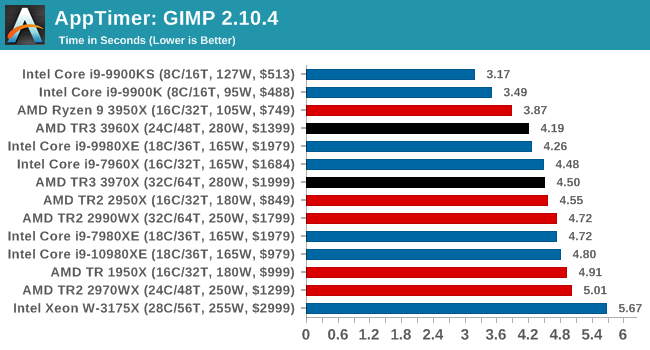
Onto our single threaded tests, and the mainstream hardware with high single thread frequencies wins here, but the 3960X is leading the rest of the pack. Intel's 28-core part here sits last, behind even the 1950X.
3D Particle Movement v2.1: Brownian Motion
Our 3DPM test is a custom built benchmark designed to simulate six different particle movement algorithms of points in a 3D space. The algorithms were developed as part of my PhD., and while ultimately perform best on a GPU, provide a good idea on how instruction streams are interpreted by different microarchitectures.
A key part of the algorithms is the random number generation – we use relatively fast generation which ends up implementing dependency chains in the code. The upgrade over the naïve first version of this code solved for false sharing in the caches, a major bottleneck. We are also looking at AVX2 and AVX512 versions of this benchmark for future reviews.
For this test, we run a stock particle set over the six algorithms for 20 seconds apiece, with 10 second pauses, and report the total rate of particle movement, in millions of operations (movements) per second. We have a non-AVX version and an AVX version, with the latter implementing AVX512 and AVX2 where possible.
3DPM v2.1 can be downloaded from our server: 3DPMv2.1.rar (13.0 MB)
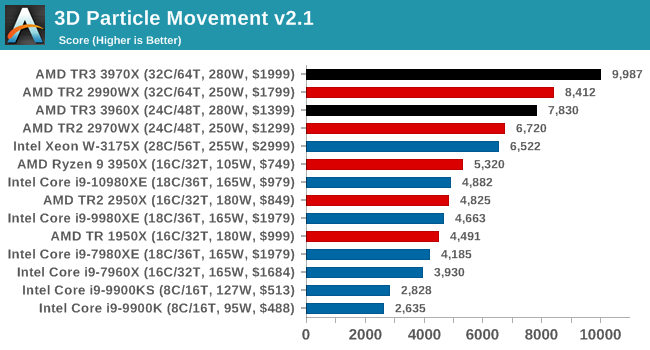
With non-AVX, AMD's floating point units put on a great performance.

This is a workload that can be AVX512 accelerated, and this is the main instance where we can see Intel's CPUs having an advantage.
Dolphin 5.0: Console Emulation
One of the popular requested tests in our suite is to do with console emulation. Being able to pick up a game from an older system and run it as expected depends on the overhead of the emulator: it takes a significantly more powerful x86 system to be able to accurately emulate an older non-x86 console, especially if code for that console was made to abuse certain physical bugs in the hardware.
For our test, we use the popular Dolphin emulation software, and run a compute project through it to determine how close to a standard console system our processors can emulate. In this test, a Nintendo Wii would take around 1050 seconds.
The latest version of Dolphin can be downloaded from https://dolphin-emu.org/
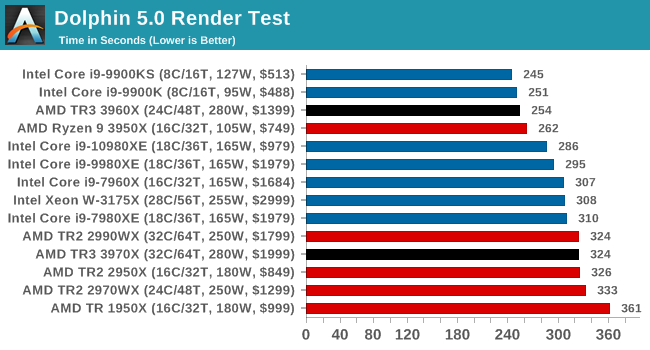
On the single threaded workloads again, and the high frequency mainstream CPUs win here. Interestingly, the 3960X also puts on a really good show, and actually beats our 3950X. Interesting.
DigiCortex 1.20: Sea Slug Brain Simulation
This benchmark was originally designed for simulation and visualization of neuron and synapse activity, as is commonly found in the brain. The software comes with a variety of benchmark modes, and we take the small benchmark which runs a 32k neuron / 1.8B synapse simulation, equivalent to a Sea Slug.
Example of a 2.1B neuron simulation
We report the results as the ability to simulate the data as a fraction of real-time, so anything above a ‘one’ is suitable for real-time work. Out of the two modes, a ‘non-firing’ mode which is DRAM heavy and a ‘firing’ mode which has CPU work, we choose the latter. Despite this, the benchmark is still affected by DRAM speed a fair amount.
DigiCortex can be downloaded from http://www.digicortex.net/
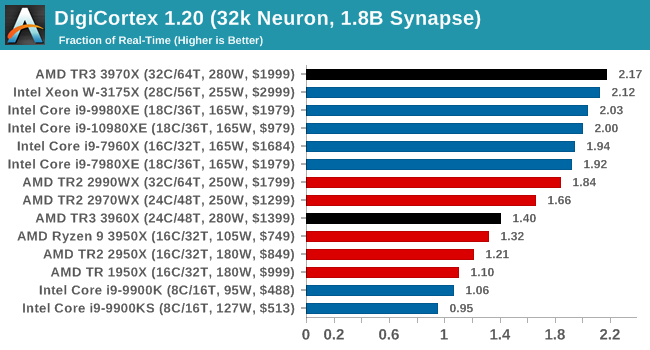
I'm surprised there's that much difference between the 3970X and 3960X here, especially with the 3960X sitting behind the TR2 processors. Might have to re-run this one to double check. But the 3970X puts out a commanding lead.
y-Cruncher v0.7.6: Microarchitecture Optimized Compute
I’ve known about y-Cruncher for a while, as a tool to help compute various mathematical constants, but it wasn’t until I began talking with its developer, Alex Yee, a researcher from NWU and now software optimization developer, that I realized that he has optimized the software like crazy to get the best performance. Naturally, any simulation that can take 20+ days can benefit from a 1% performance increase! Alex started y-cruncher as a high-school project, but it is now at a state where Alex is keeping it up to date to take advantage of the latest instruction sets before they are even made available in hardware.
For our test we run y-cruncher v0.7.6 through all the different optimized variants of the binary, single threaded and multi-threaded, including the AVX-512 optimized binaries. The test is to calculate 250m digits of Pi, and we use the single threaded and multi-threaded versions of this test.
Users can download y-cruncher from Alex’s website: http://www.numberworld.org/y-cruncher/
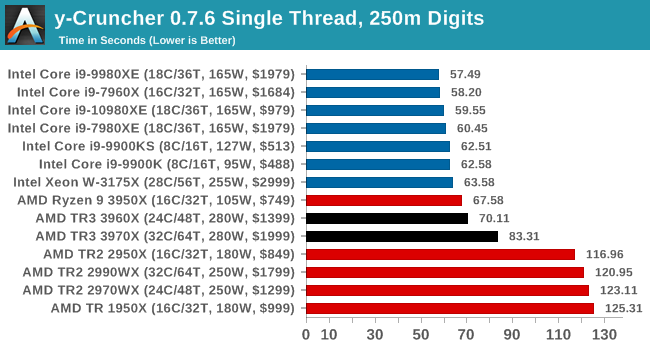
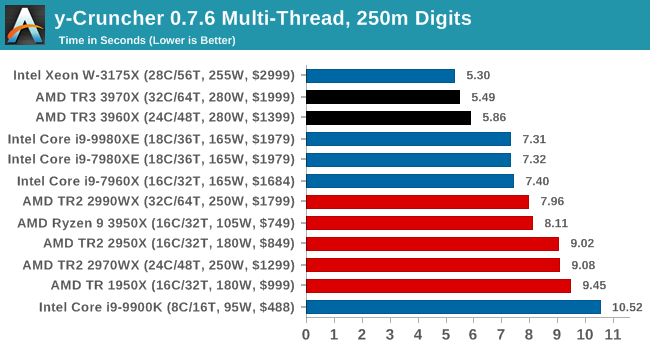
y-Cruncher is also AVX-512 accelerated, however when all the 32 threads come together in MT mode on AVX2, having that many pushes through 18 cores with AVX-512.
Agisoft Photoscan 1.3.3: 2D Image to 3D Model Conversion
One of the ISVs that we have worked with for a number of years is Agisoft, who develop software called PhotoScan that transforms a number of 2D images into a 3D model. This is an important tool in model development and archiving, and relies on a number of single threaded and multi-threaded algorithms to go from one side of the computation to the other.
In our test, we take v1.3.3 of the software with a good sized data set of 84 x 18 megapixel photos and push it through a reasonably fast variant of the algorithms, but is still more stringent than our 2017 test. We report the total time to complete the process.
Agisoft’s Photoscan website can be found here: http://www.agisoft.com/

New records for Photoscan as well.












245 Comments
View All Comments
jmelgaard - Monday, November 25, 2019 - link
They also somehow forgot that AMD has been virtually invisible in the desktop CPU market for the last ~10 years, yet they managed to survive and pull this incredible victory.But for some reason, that would be unthinkable that Intel could turn things around... o.O... Pure idiocracy...
Besides, it doesn't matter if your an AMD or Intel fan, if you don't wan't both to be in the game your a pure moron, the status quo we have seen from Intel the past 10 years is exactly what we will see if they aren't both in the game. They are there to push each other, to the overall benefit for us, the consumers. If Intel really where to go out of business, then AMD would just begin to milk...
It's f****** amazing how dumb some people are...
AMD has the absolute and clear victory this time, if Intel has anything meaningful to respond with in the near future, well only time can tell...
But for now... Lets just praise what AMD has done, cheer for the amazing launch and well earned victory after what can only have been 10 long years of hard work, and hope that Intel returns... Hopefully sooner than AMD did... Or... On the other hand it's been 10 rather cheap years computer wise for me, so... perhaps I should cheer for Intel to take 10 years for a decent knockout punch in the other direction...
DannyH246 - Monday, November 25, 2019 - link
Intel will DEFINITELY return and with Jim Keller on board i'm sure in 2-3 years they will return with a vengeance. I do hope however that everyone remembers what we have been saddled with from Intel for the last 10 years...No innovation, crazy pricing, artificial market segmentation, forced new motherboard purchases every year etc etc. In short - Intel have shafted us for years and are only working like crazy now because AMD launched a rocket up their back sides. Lets hope AMD continues innovating & executing as they have been. That's not Fanboyism, its just common sense.lobz - Tuesday, November 26, 2019 - link
What gap in IPC? You think intel's Coffee Lake has a higher IPC than Zen 2? Please get your facts straight before you try to criticize other people's comments.Der Keyser - Monday, November 25, 2019 - link
AMD are really doing wonders with their ZEN2 architecture :-)But with the latest pricing of the higher end R7 and R9 and now TR I think they are making a GREAT mistake. They have decided to capitalize on having reached their target of beating Intel on performance. So prices are no longer vastly better than Intel, and we are moving into having AMD/INTEL pricing close enough not to matter to the average consumer.
This is a very short sighted decision as AMD right now has a once in a lifetime opportunity to really kick Intel in the n***. Intel’s production capability and proces node is lagging - as is their architecture. This is the time to set pricing and performance at a level were DELL, HP, LENOVO and so on are unable to ignore or downplay the AMD option because of intel funding - because that is happening now, and will continue when AMD is getting similarly expensive.
Ditch the lower end SKU’s and drop the prices on mid and high-end SKUs with 20 - 30% now and gain what AMD never had before: Market superiority to really establish their name as a household processor brand. Will all know Intel will retaliate within the next two years once their 10 and 7nm comes full online, and once that happens, AMD will once again battle with the “unproven and small player” moniker because they never got REALLY big - Getting rid of that moniker should be their second and REAL goal of this ZEN2 era. This short term money grab with the new pricing is what will keep AMD in the shadows of Intel going forward.
liquid_c - Tuesday, November 26, 2019 - link
This! So much this! I have no brand loyalty but somehow, people either chose to forget all of AMD’s mishaps (fake turbo boosts, pricing during their Athlon days, declaration of MB compatibility with future CPU gens but when time comes, they point fingers at MB vendors, etc.)liquid_c - Tuesday, November 26, 2019 - link
...or they hate Intel that much (no edit button..)Korguz - Tuesday, November 26, 2019 - link
liquid_c looks like you may be used to the way intel does things, have you seen this article :https://www.anandtech.com/show/15137/amd-clarifies...
or this one :
https://www.anandtech.com/show/14873/reaching-for-...
and what about intels TDP ratings on their cpus ?? people harped and criticized amd for the power their cpus used before zen, but, yet, when intel does the same... it seems to be ok ??
or, that just hate amd that much ....
peevee - Monday, November 25, 2019 - link
Too bad the test actually relevant to the class of CPUs, namely compilation, is gone.Also looks like some results are old, before OS and BIOS patches for security (Intel) and performance (AMD).
tony p - Monday, November 25, 2019 - link
does anyone know can I swap CPU heatsink between Socket TR4 and TR3Slash3 - Tuesday, November 26, 2019 - link
X399 and TRX40 boards use the same physical socket - heatsinks are compatible with all three generations of Threadripper.